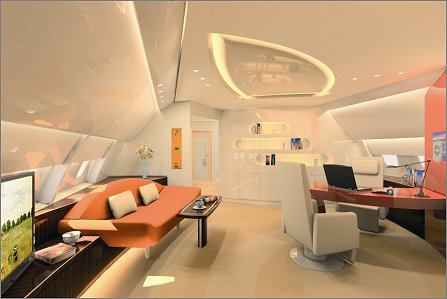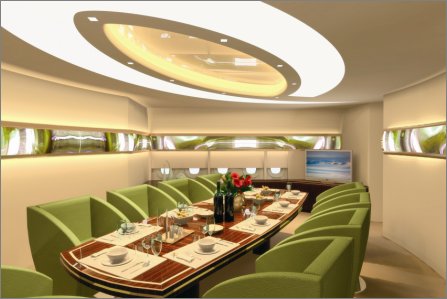JULIAN MOXON / LONDON
There are few refurbishment challenges more specialised and demanding than the conversion of commercial airliner interiors to VIP specification
When VVIP aircraft buyers spend up to $100 million for a top-of-the-range completion they expect the best. Providing such a service is the domain of only four or five companies, and their job is to translate often extraordinary requirements into a result that satisfies not only the customer, but the certification authorities.
The VIP interiors business was one of the few aviation sectors with optimism after 9/11, based on the premise that the super-rich and corporate chiefs would opt for private rather than public transport. But the market failed to materialise, reflecting the deep insecurity caused by the terrorist attacks and subsequent events.
|
| Lufthansa Technik includes a conference dining room in its concept of the A380 main deck |
 |
| the upper deck includes a separate office area in the forward cabin |
 |
| Mood lighting is one of the latest features to become popular with today's VVIP traveller |
All this has changed, however, with VVIP/VIP interior specialists reporting a strong upswing in business since 2004. At Jet Aviation’s completion centre at Basle, Switzerland, the number of staff dedicated to VIP modifications has more than doubled in the past two years, from 450 to 1,000, with near-term growth in the top-of-the-range widebody sector predicted at 15-30% a year over 2005.
Jet Aviation does not provide figures for its turnover in the sector, but completions and modifications director Eugen Hartl expects demand to continue as more and more business arrives from areas with the fastest-growing economies, such as India and Russia. “The trend is towards bigger aircraft. People really want comfort and range these days, and you can get a Boeing BBJ for not very much more than a Gulfstream G550. And the BBJ is a lot bigger,” he says.
Lufthansa Technik’s (LHT) completion centre at Hamburg is also experiencing record business in both narrow- and widebody sectors. The popularity of both the Airbus A319CJ and Boeing BBJ conversions is increasing all the time, for VIP and VVIP use, as well as for governments and corporations, says Walter Heerdt, LHT senior vice-president marketing and sales. “We’re seeing strong interest from India, Russia and the Middle East and we think China will also become a strong market,” he says. Heerdt believes the Chinese authorities are “softening up” their stance on general aviation. “We’ll see the first Challenger-sized aircraft over there in three or four years and they will be followed by ACJs and BBJs.” Hartl agrees: “There needs to be a big change in mentality before anything major happens in China, but we’re certain it is going to happen.”
The widebody VIP/VVIP market is also robust, says Heerdt, who reports “strong interest” in VVIP conversions on the new Airbus A350 and Boeing 787 medium-range aircraft. A growing number of A330s are being given the VIP treatment for government and private customers, mainly in the Middle East, and demand for A340s continues, including a recent order for the larger A340-600 – although Heerdt admits: “It is not clear who will complete it.”
Russian growth
“Traditionally, most VVIP conversion business has been generated by the Middle East,” says Hartl. “Now we’re seeing really strong growth from Russia and we think there is plenty of potential for further increases in business there. This is a new breed of people who can afford the best, and they’re asking for everything: bathrooms, dining areas, bedrooms, libraries, children’s rooms. You name it, they want it.” He believes Russia could dominate the sector within five years, exceeding even the Middle East in its demand for the ultimate in opulence. Growth is also coming from the South American market, especially in Brazil, and mainly in the business jet segment. India’s fast-growing economy is fuelling demand, too. “We see a lot of interest in the Airbus ACJ and Boeing BBJ for both VIP and corporate transport,” he adds.
Jet Aviation recently completed the acquisition of US-based Midcoast Aviation, marking its first step in a growth strategy that will strengthen the European company’s offshore position. Midcoast specialises in high-end business jets and was looking for a complementary tie-up to strengthen its VIP business base. “We’ll now become a major provider of completions, modifications and maintenance in North America,” says the US company. “We’re a perfect fit with Jet Aviation.”
In March, LHT signed a deal with Airbus to perform cabin outfitting for A318 Elites, the VIP version of the A318 launched by Airbus at the NBAA show in September 2005. Since its launch, 13 Elites have been sold, with options on 13 more. The design of the cabin, which is offered in 14- and 18-seat configurations, reflects a significant change in the way Lufthansa is approaching the corporate VIP end of the market, which it has applied to its Leadership Select version of the Boeing Business Jet (BBJ), also launched at the show. “We took an initiative on a VIP-style cabin based mainly around a standardised design,” says Heerdt. “It means we can offer an attractive price and delivery combination because we have already done the engineering work and pre-manufactured some of the parts.” The result is delivery of the complete aircraft within six months instead of between nine and 12 months, he adds. The Leadership Select package allows BBJ customers to choose an interior from pre-defined components, while retaining access to a substantial pool of pre-selected materials and a large colour palette. Customers also have the choice of in-flight entertainment package and cabin lighting systems.
The giant A380 is also attracting interest – although customers will have to wait until delivery slots become available. Heerdt says “at least two” potential customers are already interested in VVIP conversions for the aircraft, but declines to disclose where they are based as “only a very few people have the resources – and it would be obvious who they are. We see a market demand for between three and five aircraft.”
At the 2005 Dubai air show LHT revealed its concept for upper- and lower- deck VVIP A380 conversions, in which the main deck includes a forward lounge, meeting rooms, the main galley, a spacious royal lounge and a dedicated dining and conference area. The upper deck would be reserved for the owner and guests and features a private lounge, galley and two guest rooms with en-suite bathrooms and showers. Finally, the VVIP area contains a private office, bedroom with dressing area, bathroom and fitness room including a steam bath. “We think we could complete such an aircraft in the same time as for a Boeing 747 by treating it as if it were a pair of A340s,” says Heerdt. He points out that LHT also offers “cradle to grave” maintenance and support for the A380 through its partnership with Air France Industries.
Top of the ACJ league
In March, Tempe, Arizona-based Associated Air Center (AAC) signed its tenth Airbus ACJ completion deal and claims to be the “world’s number one completion centre for the ACJ”, with six aircraft delivered and a further four in the completion process.
AAC president Jeff Bosque describes the VVIP completions business as “extremely strong. We have an unprecedented backlog, with jobs booked to the second quarter of 2007.” He attributes the success to strong backing from parent company, Landmark Aviation, and to the lower cost of the work compared with European completion centres because of the weak position of the dollar against the euro.
AAC also sees rising business from Asia, India, Russia and potentially China, its most recent ACJ and BBJ deals having been with private Asian companies. Bosque says the ACJ and BBJ will remain the company’s main line of business.
AAC is open to other business, however, having completed several Boeing 757s and last year a 747-400, which Bosque describes as “the most exotic aircraft flying”. In terms of engineering changes alone the demand was unprecedented, he says. “The customer even wanted the stairs to the upper deck moved 15ft [4.6m] forwards to provide a bigger upper deck. We designed, engineered and certified all of the engineering changes,” he adds. While declining to be specific, he reveals that the job, understood to be for a Middle Eastern client, and costing “around $100 million”, included “undulatory effects throughout the aircraft. There are no right angles in the cabin whatsoever.”
Source: Flight International
























